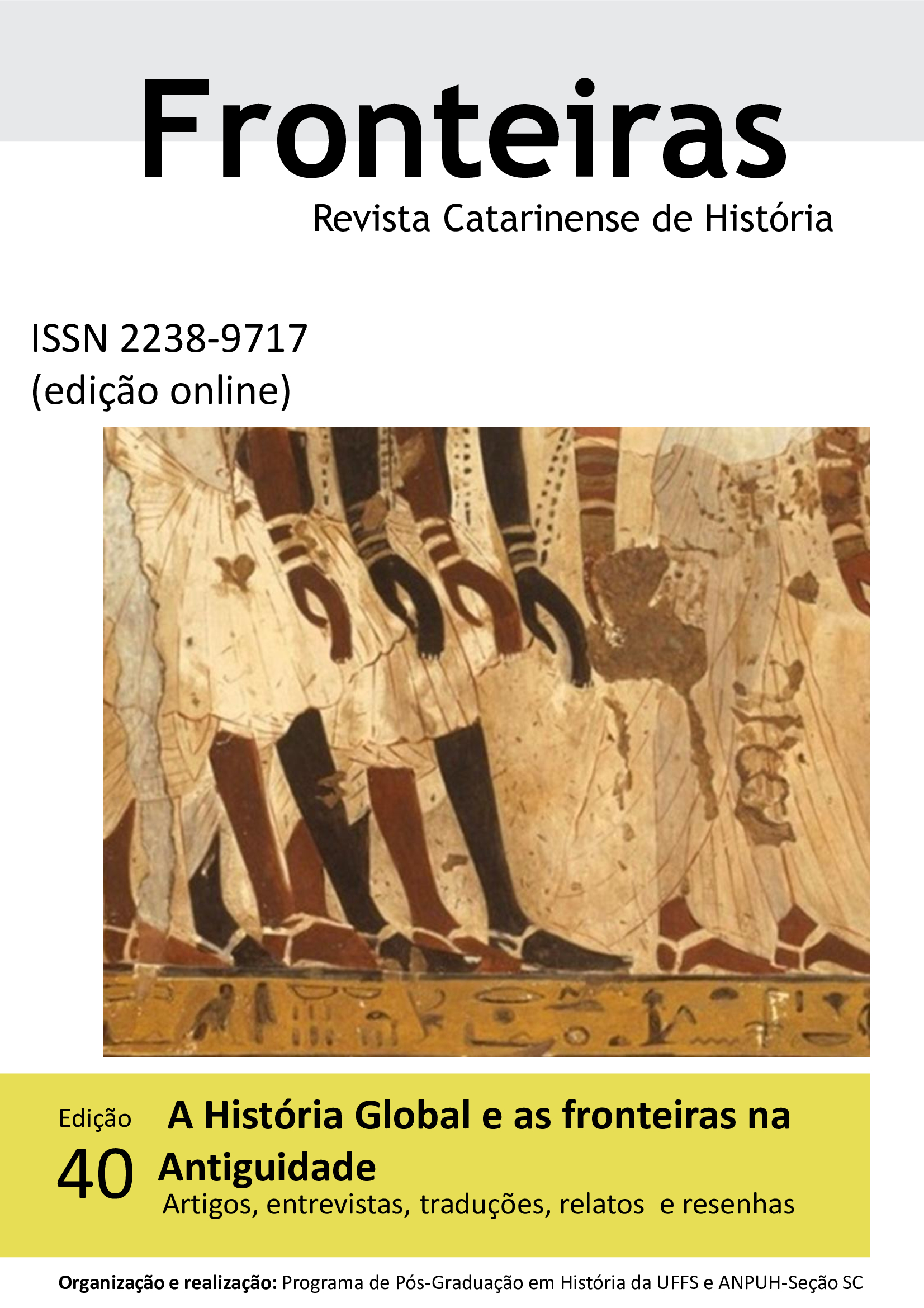Exército Romano
um agente do Emaranhamento Cultural
DOI:
https://doi.org/10.36661/2238-9717.2022n40.12940Palavras-chave:
Exército Romano, Emaranhamento Cultural, Divindades Femininas PluraisResumo
Em um brevíssimo estudo sobre as dedicações epigráficas às divindades femininas plurais de quatro províncias ocidentais do Império Romano (Germânia Inferior, Bética, Gália Lugdunense e Britânia), concluímos que as populações locais não permaneceram passivas à ocupação de seus territórios, mas adotaram, rejeitaram e ressignificaram elementos da religiosidade que lhes chegavam de fora, mantendo, igualmente, elementos e práticas preexistentes. Tal estudo se insere nas atuais pesquisas sobre Império Romano, que demonstram a impossibilidade de compreendê-lo como um sistema homogêneo, no qual os romanos, entendidos como um grupo coeso e indistinto, utilizavam seu poderio bélico para subjugar populações igualmente homogêneas e pouco complexas. Ao invés, verificamos a grande heterogeneidade étnica e cultural dos membros do Exército que, aliada a variabilidade cultural presente nas províncias, possibilitou a disseminação de práticas romanizadas e regionais, bem como a criação de novas práticas emaranhadas.
Downloads
Referências
ALLASON-JONES, L. Coventina’s Well. In: BILLINGTON, S.; GREEN, M. The Concept of Goddess. London & New York: Routledge, (1996) 2004.
BHABHA, H. O Local da Cultura. Belo Horizonte: Editora UFMG, 1998.
BIRLEY, A. R. Making Emperors. Imperial Instrument or Independence Force? In: ERDKAMP, P. Companion to Roman Army. Australia: BlackWell Publishing, (1998) 2007.
BLASCO, D. A. A. Matres y divinidades afines de carácter plural em la Hispania Antigua. Tese de Doutorado. Universitat de Valencia. Valencia, 2015.
D’ANATO, R.; RUGERI, R. Roman Army Units in the Western Provinces 31 BC–AD 195. Osprey Publishing Ltd., 2016.
FIELDS, N. The Roman Army of the Principate, 27 BC - AD 117. Osprey Publishing Ltd, 2009.
GARMAN, A. G. The Cult of the Matronae in the Roman Rhineland: An Historical Evaluation of the Archaeological Evidence. Lewiston, NY: Edwin Mellen Press, 2008.
HINGLEY, R. Resistance and Domination: Social Change in Roman Britain, In: JONES, S. The Archaeology of Ethnicity. Londres e Nova York: Routledge, 1997.
HINGLEY, R. O Imperialismo Romano: Novas perspectivas a partir da Bretanha. Campinas: Annablume, 2010.
JIMÉNEZ, A. Pure hybridism: Late Iron Age sculpture in southern Iberia. In: World Archaeology, Vol. 43(1), pp. 102-123. Taylor & Francis, 2011.
LEHNER, H. Die antiken Steindenkmäler des Provinzialmuseums in Bonn. Bonn, 1919.
NEUMANN, G. Die germanischen Matronen-Beinamen. In: Bauchhenss & Neumann, pp. 103-132, 1987.
PALACIUS, F F. O teônimo Conventina. In.: R Haeussler e King, A. Religiões celtas no período romano: pessoal, local e global. Aberystwyth, Ceredigion, País de Gales; Havertown, Pa: Publicações de Estudos Celtas, 2017.
PEDREIRA, E. V. O Triplismo em revisão. Estudos de caso: Hispânia, Gália e Britânia Romana. Brathair, n. 18 (1), p. 71-87, 2018.
RAYBOULD, M. E. A Study of Inscribed Material from Roman Britain. An inquiry into some aspects of literacy in Romano British society. Oxford: Archaeopress, BAR British Series 281, 1999.
ROTH, J. P. The Logistics of the Roman Army at War: 264 B.C. - A.D. 235. Leiden, Boston, Colônia: Brill, 1999.
ROYMANS, N. The Batavians in the Early Roman Empire. Ethnic Identity and Imperial Power. Amsterdam: Amsterdam University Press, 2004.
SOUTHERN, P. The Roman Army. A social and Instituonal History. ABC-CLIO, Inc, 2006.
STOCKHAMMER, Ph. Questioning Hybridity. In: STOCKHAMMER, Ph. (ed.) Conceptualizing Cultural Hybridization: a transdisciplinary approach. Heidelberg: Springer, p.1-4, 2012.
STOCKHAMMER, Ph. Conceptualizing Cultural Hybridization in Archaeology. In: STOCKHAMMER, Ph. (ed.) Conceptualizing Cultural Hybridization: a transdisciplinary approach. Heidelberg: Springer, p. 43-58, 2012b.
STOCKHAMMER, Ph. From Hybridity to Entanglement, From Essentialism to Practice. In: PELT. W. P. (ed.). Archaeology and Cultural Mixture. Archaeological Review. Cambridge, v. 28.1, p. 12-28, 2013.
STOLL, O. The Religions of the Armies. In: ERDKAMP, P. Companion to Roman Army. Australia: BlackWell Publishing, 2007.
VAN DOMMELEN, P. Colonialism and Migration in the Ancient Mediterranean. In: The Annual Review of Anthropology. 41: 393-409, 2012.
WEBSTER, G. The British Celts and their Gods under Rome. London: Batsford, 1986;
WEBSTER, J. Necessary Comparisons: A Post-Colonial approach to religious syncretism in the Roman provinces. In: World Archeology, Culture, Contrast and Colonialism, vol.28, n.3 Londres: Taylor & Francis, 1997.
WEBSTER, J. A negotiated sincretism: readings on the development of Romano-Celtic religion. Portsmouth: Oxbow Books, 1997.
WEBSTER, J. Art as Resistance and Negotiation. In: S. e. SCOTT, J. W. Roman Imperialism and Provincial Art. Cambridge: Cambridge University, 2003.
WHITTAKER, C. R. Supplying the army. Evidence from Vindolanda. In: EDIRKAMP, P. The Roman Army and the Economy. Brill Academic Pub, 2002.
WIERSCHOWSKI, L. Heer und Wirtschaft: Das römische Heer der Prinzipatzeit als Wirtschaftsfaktor. Bonn: Habelt, 1984.
WIERSCHOWSKI, L. Das römische Heer und die ökonomische Entwicklung Germaniens in den ersten Jahrzehnten des 1. Jahrhunderts. In: EDIRKAMP, P. The Roman Army and the Economy. Brill Academic Pub, 2002.
WOOLF, G. World systems analysis and the Roman Empire. In: Journal of Roman Archaeology 3, 1990.
WOOLF, G. Becoming Roman. The Origins of Provincial Civilization in Gaul. Cambridge: Cambridge University Press, 1998.
WOOLF, G. Inventing Empire in Ancient Rome. In: ALCOCK, S.E, D´AlTROY T.E. et all (orgs.). Empires. Cambridge: Cambridge University Press, 2001.
WOOLF, G. Provincial Perspectives, In: GALINSKY, K. (org.). The Cambridge Companion
to the Age of Augustus. Cambridge: Cambridge University Press, 2005.
Sites consultados (documentação epigráfica)
Corpus Inscriptionum Latinarum.
Disponível em: http://cil.bbaw.de/cil_en/index_en.html.
Epigraphic Database Heidelberg.
Disponível: em https://edh.ub.uni-heidelberg.de/inschrift/suche.
Hispania Epigráfica.
Disponível em: http://eda-bea.es/.



















